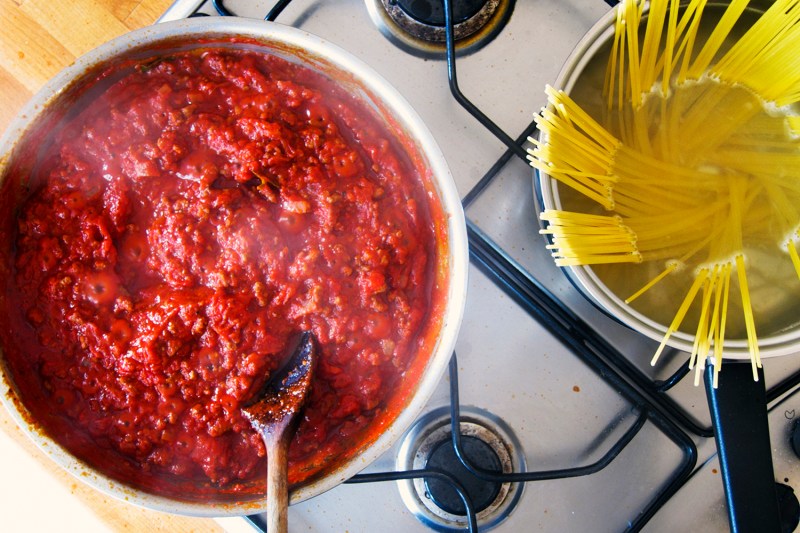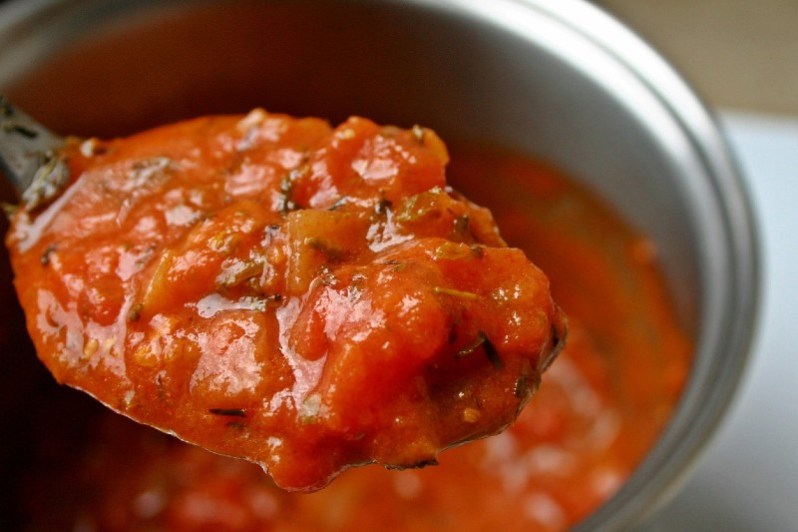
Spaghetti sauce is subjective stuff. Most who make batches claim their recipe is the best, thanks to a few extra ingredients or a few secrets they’re unwilling to make public.
Regardless of how it’s put together, it’s impossible to go wrong with a good red sauce. As renowned chef Jamie Oliver says, the sauce serves as a lovely base atop which you can tinker and experiment. Once you get the gist of the sauce taken care of, you can spend the rest of the week fine-tuning and playing with various riffs on the traditional spaghetti. And for the record, Oliver’s spaghetti sauce is arguably the best out there, for a couple of key reasons.
First, he champions fresh basil. The powerful herb invigorates spaghetti sauce, both aromatically and in terms of flavor. Secondly, Oliver doesn’t overdo it with the garlic. We’re not trying to drive away vampires. We’re trying to make some succulent spaghetti worthy of a nice bottle of chianti or American pinot noir. Lastly, Oliver opts for a tasty injection of acid via red wine or balsamic. This is a great way to use the previous night’s Cabernet or Merlot while improving the backbone of your spaghetti sauce.

Spaghetti sauce advice
Overall, it’s a simple recipe, as it should be when it comes to good spaghetti sauce. We encourage you to trick it out with additions like meatballs, diced olives, and even octopus if seafood is your thing. In terms of pasta, your run-of-the-mill spaghetti kind is perfectly adequate, but you can really elevate the whole meal by using something like bucatini. For a healthier take, try whole-wheat pasta. Play around with herb and spice additions, too, namely in the form of lemon pepper, tarragon, oregano, and thyme.
One of the best things about spaghetti sauce is that once everything is in the pot and simmering, it pretty much makes itself. You just get to sit back, beverage in hand, and let the flavors mesh. While you are preparing, though, do as the Italians do: Use quality olive oil throughout and find a good sauce-to-pasta ratio. The Olive Garden has taught us to heap massive globs atop our pasta, but we’re not making a stew or tomato soup, we’re making spaghetti. Show some restraint and start small. You can always add more as you mix the pasta and sauce together (it’s harder to do the opposite).
There are a couple of other easy things you can do to improve your spaghetti game. Try getting whole parmesan (or pecorino, grana padano, etc.) instead of the shredded version. If tomatoes are in season or you have access to nice vine-ripened ones, go that route. Otherwise, opt for a quality can of diced tomatoes like Cento.

Try this spaghetti sauce recipe
Remember that spaghetti sauce will keep for a while in the fridge, so feel free to double or triple up on the following recipe to have some pre-made for next time. Here’s the best spaghetti sauce recipe, by way of our guy Jamie Oliver.
Ingredients
- 1 bunch of fresh basil
- 1 medium onion
- 2 cloves of garlic
- 2 8-ounce cans of chopped tomatoes (use fresh equivalent if in season)
- 1 tablespoon of red wine or balsamic vinegar
- 1 box of pasta (16 ounces)
- Olive oil
- A small wedge of parmesan cheese
Method
- Pick the basil leaves onto a cutting board (reserving a few baby leaves to garnish), then roughly chop the remaining leaves and finely chop the stalks.
- Peel and finely slice the onion and garlic. If using fresh, cut the tomatoes in half, then roughly chop them or carefully open the cans of tomatoes.
- Put a saucepan on medium heat and add 1 tablespoon of olive oil and the onion, then cook for around 7 minutes, or until soft and lightly golden.
- Stir in the garlic and basil stalks for a few minutes, then add the fresh or tinned tomatoes and the vinegar.
- Season with a tiny pinch of salt and pepper, then continue cooking for around 15 minutes, stirring occasionally.
- Stir in the chopped basil leaves, then reduce to low and leave to tick away.
- Carefully fill large pot three-quarters of the way up with boiling water, add a tiny pinch of salt and bring back to the boil.
- Add the spaghetti and cook according to packet instructions — you want to cook your pasta until it is al dente. This translates as “to the tooth” and means that it should be soft enough to eat, but still have a bit of a bite and firmness to it. Use the timings on the packet instructions as a guide, but try some just before the time is up to make sure it’s perfectly cooked.
- Once the pasta is done, ladle out and reserve a cup of the cooking water and keep it to one side, then drain in a colander over the sink and tip the spaghetti back into the pot.
- Stir the spaghetti into the sauce, adding a splash of the pasta water to loosen, if needed.
- Serve with the reserved basil leaves sprinkled over the top and use a microplane to finely grate the cheese nd then sprinkle over.

What can I add to spaghetti sauce to make it taste better?
In addition to all that Oliver has offered above, there are other things you should keep in mind that will almost always benefit a good spaghetti sauce. Consider olives, capers, anchovies, and changing up your balsamic vinegar, as there are so many options to choose from. If you’re a vegetable person, consider mincing things like carrots and eggplant with a food processor and throwing them in the mix. For a little kick, add a few dashes of red pepper flakes. And in terms of herbs, try out a few others, like tarragon, oregano, thyme, and fresh parsley.
Get cracking — it’s time to elevate your spaghetti sauce game. Whether you’re hosting a party or cooking for two, the above recipe will please the masses. Better, it’s not too tricky to pull off and you can tweak it as you see fit, trying new combinations of like-minded ingredients.


